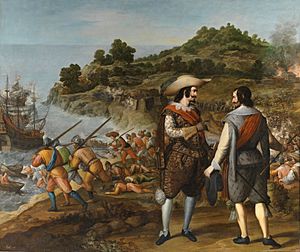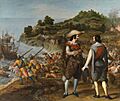Battle of San Juan (1625) facts for kids
Quick facts for kids Battle of San Juan (1625) |
|||||||
|---|---|---|---|---|---|---|---|
| Part of the Eighty Years' War | |||||||
 Seventeenth-century Spanish painting commemorating Hendricksz's defeat at San Juan de Puerto Rico. By Eugenio Caxés, Museo del Prado. |
|||||||
|
|||||||
| Belligerents | |||||||
| Commanders and leaders | |||||||
The Battle of San Juan happened on September 29, 1625. It was a fight during the Eighty Years' War. A Dutch group led by Boudewijn Hendricksz attacked Puerto Rico. They tried to capture San Juan for two months but could not take it from Spain. This battle showed how important San Juan was for Spain.
Contents
Why Did the Battle Happen?
The Twelve Years' Truce was a peace agreement that ended in 1621. After this, the Dutch Republic wanted to expand its trade. They formed the Dutch West India Company. This company helped pay for ships to attack Spanish and Portuguese trading vessels. The Dutch aimed to weaken Spain's power in the New World.
How the Battle Unfolded
Dutch Ships Arrive in San Juan
On September 24, 1625, 17 Dutch ships arrived at San Juan, Puerto Rico. The Spanish governor, Juan de Haro y Sanvitores, had just started his job. He quickly prepared for the attack. He set up cannons at El Morro fort. This fort guarded the main entrance to San Juan Bay.
He also sent soldiers to stop the Dutch from landing. They placed cannons at other key spots. Trenches were dug to protect the land.
The Dutch Attack San Juan Bay
The next day, the Dutch fleet sailed directly into San Juan's harbor. Their main ship led the way. Both sides fired their cannons. The Dutch ships passed El Morro fort. The Dutch flagship had only a few people killed or hurt.
However, shallow waters stopped the Dutch from landing troops right away. This delay helped the Spanish. Civilians quickly left the city. Governor de Haro gathered his 330 men inside El Morro fort.
Dutch Take the City, But Not the Fort
On September 26, Boudewijn Hendricksz led 800 Dutch soldiers ashore. They took over the empty city of San Juan. They made La Fortaleza their main base. The Dutch also took control of El Cañuelo and the San Antonio Bridge. This cut off supplies to El Morro fort.
The Dutch started digging trenches for a siege. They set up a battery of six cannons. Hendricksz demanded that the fort surrender. He threatened to harm everyone if they did not give up. Governor de Haro refused. He even joked that he would let the Dutch have one ship to go home if they gave him the rest.
The Cannon Duel Begins
After this, a 21-day cannon battle began. El Morro fort fired back at the Dutch. But Puerto Rican soldiers fought back too. They recaptured the San Antonio Bridge. Other local fighters took back control of the Bayamón River. They also burned El Cañuelo.
This meant supplies could reach El Morro fort again. The Dutch siege trenches had reached close to El Morro's walls. On October 4, Governor de Haro ordered his men to attack the Dutch. These small attacks, called sorties, were led by brave captains like Juan de Amézqueta.
The Dutch Burn the City
On October 21, Hendricksz again told de Haro to surrender. He threatened to burn the town. De Haro bravely replied that they had enough courage and materials to rebuild.
On October 22, the Dutch started burning buildings. They destroyed over 100 houses. This included the bishop's palace and the city's old records. Captain Amézqueta led another attack from El Morro. Another captain led an attack from the San Antonio Bridge. These attacks pushed the Dutch back to their ships.
What Happened After the Battle?
The Dutch finally left San Juan on November 2. They left behind one of their ships and more than 400 dead soldiers. Spain realized it needed to make Puerto Rico's defenses even stronger. This was to prevent future attacks.
Images for kids
-
Seventeenth-century Spanish painting commemorating Hendricksz's defeat at San Juan de Puerto Rico. By Eugenio Caxés, Museo del Prado.
See also
 In Spanish: Batalla de San Juan (1625) para niños
In Spanish: Batalla de San Juan (1625) para niños
- Military history of Puerto Rico
- Annus mirabilis


